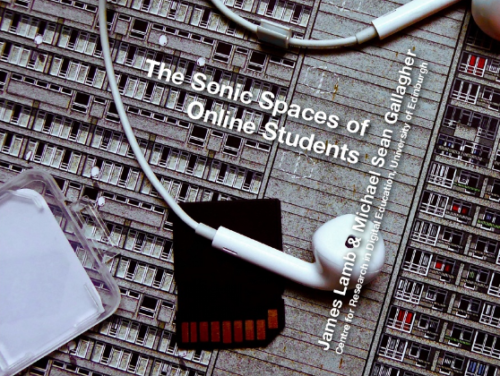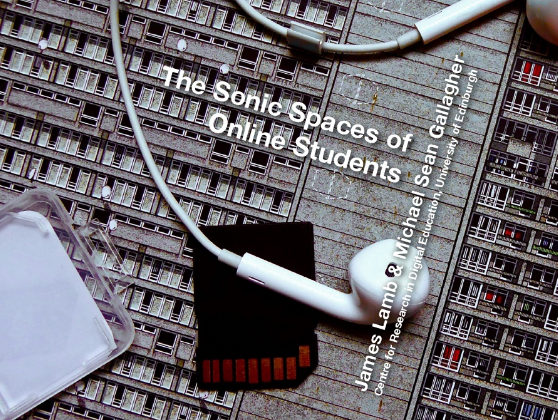
James Lamb and I presented a seminar the other day at the University of Edinburgh building on a paper we did along with Sian Bayne on the sonic spaces of online students. Update: recording now available. The paper was the third and presumably final output of the project New Geographies of Learning: distance education and being ‘at’ The University of Edinburgh. The basic premise of the project was:
Online learning provokes questions about the nature of place and institution for distance learners: what does it mean to be a student at Edinburgh who is not in Edinburgh, and what insight does this give us into learning design for high quality distance programmes?
For this particular analysis, we turned to the aural data submitted as part of the project. It wasn’t necessarily data we had neglected, but it hadn’t overtly informed our initial analysis. James and I both have an interest in this type of data (and we are both using/used it in our respective theses). It is ambient data, essentially: not inherently performative, not explicitly voices or communicative. It was essentially the sonic backdrop of the student’s learning. So we thought it deserve another look. What we found however was that there was a real dearth of research related to ambient audio. With some notable exceptions, ambient audio is more or less a distraction in the research literature. If discussed, it is generally discussed in relation to how it supports the more accessible image, video, and text. The most notable exception to this is Fluegge, E. (2011) The consideration of personal sound space. Journal of Sonic Studies. 1(1) [Online]. Fluegge gave the data handles, essentially allowing us to work with some core structures like territoriality (the idea that sound space is territory), intrusion, spatial acoustic self-determination (if and how one controls their sonic spaces), and more.
For Teachers
The seminar wasn’t necessarily about the paper but how that informs our online teaching. This idea that sound space is contested, that not everyone has the same capacity for controlling that space, that this directly affects their capacity to engage with sounded course content. Rather than say this is a cautionary tale warning against using sounded learning, we argue that there is opportunity here, but it is opportunity wrapped in equity, access, and, yes, some degree or privilege. It could be as simple as acknowledging that Skype calls or YouTube videos are problematic for some; as advanced as using ambient data directly in compositions, research, or ongoing projects. We had some exercises throughout where we asked participants to listen to some of the ambient data and identify what they were hearing. Themes of transience, domestication, and emotion (sounds feeling cold or warm) emerged from the discussion as did some potential avenues for future research. Bearing that in mind, some practical ideas that might inform your teaching:
- Consider sound in terms of content and what degree of self-determination the learner has in engaging in that content. It varies dramatically from office to home to commute, but all of these are contested in some way.
- Rather than avoid sound, embrace it as a learning subject. Even the relatively basic phone has the capacity for recording sound. Ask learners to record, describe, and submit their sounded space. Discuss issues of accessibility and territoriality. Ask them to act as teachers and consider these sounded spaces in the development of their own learning materials.
- Consider sound as compositional space. Take these ambient recordings and map them, much as James did as part of the original Edinspace project. Add to them with annotations, contextualize them, discuss. Discuss themes or patterns emerging across the compositions.
- Return to issues of access or equity: discuss sound as privileged space. Headphones as emblematic of larger economic structures. Access for those with hearing loss or impairment.
- Broaden the discussion to cultural concepts of sound: ambient sound across cultures from the heaving metropolises to the pastoral hamlets, from East Asia to Europe to Africa, all have different appropriations of din (defined a welter of discordant sounds). I have been recording these sounds on my travels for years and all inform my sense of place and cultural proprietary. The sounded exotic street by way of a recording is a good entry point to a larger discussion around culture.
- Silence and cultural touchstones: same as #5 but with a focus on silence. What role does silence play across communities and cultures? Is silence an artificial construct? How entwined are focus, mindfulness, and silence? They are conflated at times, but are they actually working in unison?
- Consider online learning engagements: how does sound allow for openings, or the possibilities of engagements with online education? Another output of the Edinspace project was a paper with Jen Ross and Hamish Macleod and myself exploring how “teachers and institutions should work to help students develop resilience in negotiating various states of nearness” with their distance education programme. “Four strategies for increasing this resilience are proposed: recognising nearness as effortful; identifying affinities; valuing perspective shifts; and designing openings.” How does sound bring us near (or push us further away) and how are openings designed as a result (or not)? That paper is open access and can be found here.
Lots to work with for teachers. The slidedeck is below.
If interested, the paper is a chapter in the Place-based Spaces for Networked Learning; citation below.
- Gallagher, M.; Lamb, J. & Bayne, S. (2017). The sound spaces of online, distance learners. In L. Carvalho, P. Goodyear & M. de Laat (Eds.) Place-based Spaces for Networked Learning. Sydney: Routledge.

RT @mseangallagher: Sonic Spaces of Online Students: Takeaways for teachers https://t.co/gMqGtrpT3g #mlearning #elearning #diged @james8584…
RT @mseangallagher: Sonic Spaces of Online Students: Takeaways for teachers https://t.co/gMqGtrpT3g #mlearning #elearning #diged @james8584…
RT @mseangallagher: Sonic Spaces of Online Students: Takeaways for teachers https://t.co/gMqGtrpT3g #mlearning #elearning #diged @james8584…
RT @mseangallagher: Sonic Spaces of Online Students: Takeaways for teachers https://t.co/gMqGtrpT3g #mlearning #elearning #diged @james8584…
RT @mseangallagher: Sonic Spaces of Online Students: Takeaways for teachers https://t.co/gMqGtrpT3g #mlearning #elearning #diged @james8584…
Consider the sounded spaces of online studensts: sound is contested and takeaways for teachers… https://t.co/dDfXrLlZP3
RT @mseangallagher: Sonic Spaces of Online Students: Takeaways for teachers https://t.co/gMqGtrpT3g #mlearning #elearning #diged @james8584…
RT @mseangallagher: Sonic Spaces of Online Students: Sound is contested and takeaways for teachers https://t.co/1TNgXRrUM0 #elearning https…
Pay atention to this important notion: Spatial acoustic self-determination (via @mseangallagher,… https://t.co/BiebDEOol3
Pay atention to this important notion: Spatial acoustic self-determination (via @mseangallagher,… https://t.co/BiebDEOol3
Another project with @james858499: Sonic Spaces of Online Students: Sound is contested and takeaways for teachers… https://t.co/Lf9iNiftO0
Sonic Spaces of Online Students: Sound is contested and takeaways for teachers https://t.co/8gsHXgXB74 #elearning… https://t.co/30u0x4fICB